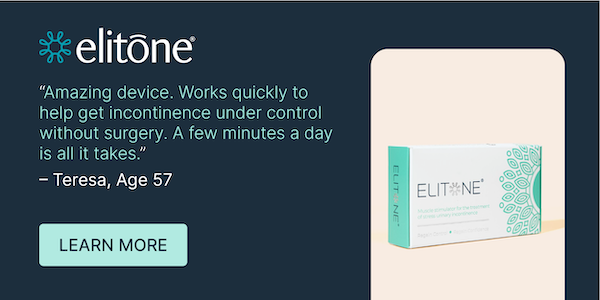If you suffer from a leaky bladder, you are not alone. Approximately 1 in 3 women struggles with stress urinary incontinence (SUI) at some point in their life. And even more shocking, only one-third of those women seek treatment through their doctors. So how are these women treating their leaky bladders, and what is the cost of incontinence?
Understanding the cost of incontinence symptoms
The most common products for managing incontinence are pads, ranging from panty liners for small leaks to absorbent pads and briefs for more severe bladder leakage. But there are other factors involved in calculating the cost of incontinence.
An NIH study showed whether you’re tackling incontinence care for yourself or a loved one, women spend an average of $750 annually for out-of-pocket incontinence management. The women in the study averaged three leaks per day and reported a decreased quality of life.
According to the research, the minimum spent on managing incontinence is $14 per week. At first, cheap incontinence pads seem less expensive than seeking medical treatment or surgery. But as women age, the frequency and severity of leaks increase, and so does the cost of managing incontinence.
Not only are pads and other products expensive, but they can also lead to additional health problems like skin irritation caused by frequent wetness. As a result, women may spend even more time on medical care and treatments for these secondary issues.
Women who struggle with incontinence reported additional loads of laundry and dry cleaning each week. For those with both SUI and urge urinary incontinence (UUI), costs were 80% higher for mixed incontinence compared with only SUI. Most women were unaware of how the increasing cost of incontinence was affecting their quality of life.
Ongoing incontinence may also results in missed work or decreased productivity at work. Frequent bathroom breaks or having to leave to change clothes can negatively impact your ability to be a productive employee. Additionally, treatments like pelvic floor therapy appointments can lead to time away from work.
Management costs v. treatment costs
Patients were also asked about their willingness to pay for improved incontinence care. They were given a scenario: if they were offered a new treatment that would reduce the number of leaks by 25%, how much would they pay? Women were open to paying an average of 31 dollars per month for a 25% reduction in symptoms, 44 dollars a month for a 50% reduction, and $118 per month for complete resolution. As expected, women were agreeable to paying more if there were a higher chance of improvement.
While 750 dollars is spent out of pocket annually just on the management of symptoms, women were willing to spend about $1,400 annually for a complete cure. This pattern of spending equals more than 1% of an average woman’s annual income each year just to manage the symptoms of incontinence, rather than investing to actually reduce or eliminate symptoms. This spending is similar to what women spend on prescription drugs each year.
Not only do the individual costs add up, but in the US, the economic price tag of incontinence is more than $20 billion per year. About 63% of that cost goes toward resources for incontinence management and care. If some of those funds were redirected to seek a cure instead of just management, people’s quality of life would improve.
Can Insurance Help With the Cost of Incontinence Products?
Since incontinence is a medical issue, it may seem like insurance should help with the cost of incontinence products. However, that often is not the case.
Medicare, for example does not cover the costs of incontinence supplies or adult diapers, even though up to 75% of women over 65 have urine leakage. This can be a significant expense for women on a fixed income. In some cases you may be able to seek reimbursement from your insurance company for incontinence products, but the process may be difficult or time consuming.
The best way to eliminate the ongoing expenses associated with incontinence is treatment for your symptoms.
Incontinence treatment options
There is hope for women suffering from incontinence, and as with most disorders, the earlier the intervention, the better the recovery rate. Speaking with a medical professional is a wise first step to determine the type and severity of incontinence, plus what treatment fits your situation. Although doing pelvic floor exercises, known as Kegels, is one of the basic recommendations for treatment, here are some other available options:
- Pelvic floor therapy requires office visits and builds up the pelvic floor muscles by targeting those muscles.
- Biofeedback records the power of contractions so patients can know if they are doing Kegels correctly.
- Vaginal weights are inserted vaginally and help patients identify which pelvic floor muscles to contract.
- Vaginal E-stim is a probe that’s inserted vaginally and stimulates pelvic floor muscles to contract.
- Surface E-stim, such as Elitone, acts similarly to vaginal E-stim but is noninvasive and can be worn under clothing anywhere. It’s also about half the cost that women spend annually on incontinence.
- Surgery is an invasive and expensive option that involves implanting material to help support the bladder.
As we age, the cost of caring for our incontinence symptoms only increases, so making the effort now to seek treatment makes financial sense in the long run.
Elitone: A Smart Investment
While all of these options can help with your incontinence and reduce the need for expensive incontinence supplies, it’s important to choose a treatment option that is not only safe and effective, but also easy for you to do consistently without interruptions to your day. Elitone can be used discreetly for just 20 minutes day. You can continue with your regular activities at home or work while Elitone tones your pelvic floor, improving your bladder control and reducing unwanted leaks. Elitone is an FDA-cleared device for treating incontinence. Most users see results in as little as six weeks. If you’re ready to reduce the costs of incontinence, then Elitone may be right for you.




Related Articles
Pelvic Floor Dysfunction and Your Lower Belly Pooch
Health Savings Account
Incontinence and Mental Health
Skin Irritation From Incontinence – 4 Tips to Help
Are Incontinence Medications Effective? 2 Types and other Safe Alternatives
Five Effective Home Remedies for Incontinence
4 Ways to Increase Female Sensitivity Naturally
Best Collagen Peptides Protein Powder for Women
5 Tips to Manage Leaks Outdoors